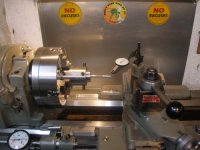I am hoping to learn from my mistake and understand better why my attempt failed.
I bought a newlon blank that was externally threaded, had a pilot hole for the reamer and was already drilled and tapped for the decapping assy.
I dialed in the die blank to as close to zero as I was able to measure the whole length of the pilot hole.
The die was supported in a steady ( first mistake?)
Used a floating reamer holder (second mistake?)
Got a nice wallowed out chamner cut .005 over.
Tried to salvage it but no go. Round file it went.
I have since bought a ptg blank that has a pilot hole all the way through and the chamber dimensions are perfect using the same technique.
What should I have done with the newlon blank instead? My immediate thought was that the reamer would have had to be held rigidly and the tailstock/spindle axis alligned perfectly for this to work. Or my floating reamer holder which is homemade and similar to a bald eagle type had too much float for the system.
Should I have chucked ober the threads instead of letting it hang out and needing the steady?
Any thoguhts welcome.
Mike
I bought a newlon blank that was externally threaded, had a pilot hole for the reamer and was already drilled and tapped for the decapping assy.
I dialed in the die blank to as close to zero as I was able to measure the whole length of the pilot hole.
The die was supported in a steady ( first mistake?)
Used a floating reamer holder (second mistake?)
Got a nice wallowed out chamner cut .005 over.
Tried to salvage it but no go. Round file it went.
I have since bought a ptg blank that has a pilot hole all the way through and the chamber dimensions are perfect using the same technique.
What should I have done with the newlon blank instead? My immediate thought was that the reamer would have had to be held rigidly and the tailstock/spindle axis alligned perfectly for this to work. Or my floating reamer holder which is homemade and similar to a bald eagle type had too much float for the system.
Should I have chucked ober the threads instead of letting it hang out and needing the steady?
Any thoguhts welcome.
Mike


